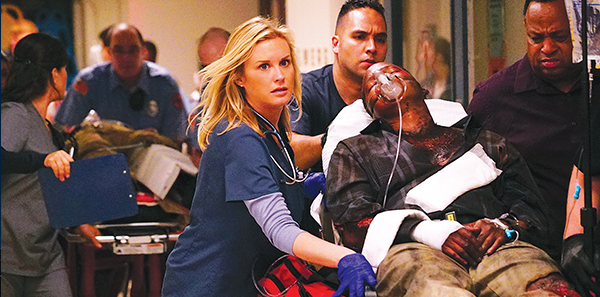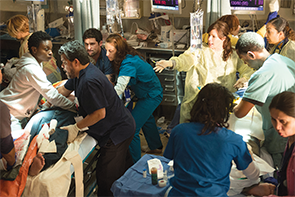
When ACEP Now last spoke with emergency physician and documentary filmmaker Ryan McGarry, MD, his film, Code Black, which chronicled life in the emergency department at University of Southern California Los Angeles County General Hospital, was receiving high praise on the documentary film circuit. Now, a year later, Code Black has made the jump from silver screen to television screens worldwide. CBS is currently airing a fictional drama series based on Dr. McGarry’s documentary Wednesdays at 10 p.m. Eastern/9 p.m. Central.
Explore This Issue
ACEP Now: Vol 34 – No 11 – November 2015Dr. McGarry recently spoke with ACEP Now Medical Editor-in-Chief Kevin Klauer, DO, EJD, FACEP, about the process of bringing Code Black to TV and the show’s commitment to an honest and accurate portrayal of emergency medicine. Here are some highlights from their conversation.
KK: You’ve had some great developments, and it sounds like all that you wanted to happen really is beginning to happen.
RM: Code Black the documentary has now been made into a fictional drama series in primetime on CBS television and will be broadcast in about 60 countries worldwide. Early on, I had shot the documentary using some techniques that are usually reserved for fiction projects, and I hoped that we could turn this into something that could reach many more people, just as ER did some 20 years ago.
KK: It is amazing. I’m so excited for you. This has to go far beyond your expectations.

PHOTOS: Cliff Lipson/CBS
Scenes from the Code Black TV series.
RM: It’s not a stretch to say that lightning has struck twice. The documentary in its own right was truly a series of miracles. Doing a film during residency comes with challenges. To have the film be viewable, let alone award-winning, is one miracle. The second deals with this incredibly rare conversion from a documentary to network television. Veteran writers and veteran producers go to bat and pitch ideas every year. Each network hears about 1,000 pitches. From the 1,000, they buy about 100 to make into scripts, and from that short list, they green-light about 10 of those to actual pilot production. The script gets made into an episode. We came in as a 1 in 1,000 pitch and with odds of 2 to 3 per 1,000 are actually going to make it on the air. I really think it is fairly accurate to say that lightning has struck twice here.
KK: How many episodes do they commit to? Do they tell you, “We’re going to do it for a whole season, we’ll do two seasons, we’re going to do a pilot of three episodes”?
RM: It’s fairly standard for a full-season order, which in network television is 22 episodes. We have our first order of 13 episodes.
KK: So how long does it take to get all those ready to go?
RM: If you can believe it, it’s a four-ring circus. We’re filming one, we’re editing another, prepping another, and writing another. A lot like emergency medicine, it’s one thing to push your patients through the system, but it’s quite another for them to leave that experience and say, “That was amazing!” That’s what we’re trying to do here.
KK: Glad you’re still able to squeeze in six shifts a month. I agree. You don’t want to close the door on your emergency medicine life, but you don’t have much time for a personal life these days, do you?
RM: No. Simple answer, no.
KK: I remember you going through the fund-raising process and trying to make sure the documentary could actually be completed and that your return on investment was what you could provide in raising awareness for emergency medicine. But I have to believe when you get noticed and your idea gets picked up for a series, without asking you the details, I hope they’re paying you properly for the work you’re doing.
RM: It is a game changer. The sad state of affairs, my friends and I joke, is that to get ahead on my medical school and educational debt, I had to sell a show to network television.
The academic quality of the show is pretty impressive. Each department has to be a student of medicine to get it right; we are unusually committed to authenticity. At one point, we cut basically raw footage of a chest tube trauma in a very high-stakes situation, and we just did an assembly cut, which means we did literally nothing to it, we just went clip for clip for clip of each step of that procedure. When we screened it internally with our docs here, they said, “I guess it’s accurate, but it doesn’t feel right.” Interestingly, when we added in a tension-laden editing process, and we added in music, “Hollywood-ized” that documentary footage in a tasteful way, suddenly it felt right, At the end of the day, that’s what we were after in this fictional series, and I think we’re doing that successfully.
Many millions of Americans learn CPR, unfortunately, through television. This is a great example of how committed we are to authenticity. We have gone to the expense of crafting a customized fiberglass frame chest that goes over the actor when patients need CPR. It allows for us to really wail and do CPR from the shoulders with locked elbows as it’s supposed to be. You see the chest recoil! Obviously, you can’t do that on a real actor who didn’t have that protection. If you’re breaking ribs on a real actor, you’ve got a problem.
KK: Let me leave you with one thought. This year, two emergency physicians have done great things individually that have really positively impacted and elevated the status of emergency medicine. Steve Stack is the president of the AMA. You’ve taken a different path, within the same year, to expose what we do to others in a positive and more accurate light. The two of you, in two very different ways, have made this a monumental time for emergency medicine. We are so proud of both of you and grateful for what you’ve accomplished.
RM: That means a whole ton, and it’s just the medicine I needed today. You would imagine that there is a mixed feeling when we see billboards and ads in L.A. and New York and everywhere in between about the show. It’s a lot of pressure, and there’s nothing like encouragement and belief when you’re under a lot of pressure. I’m very appreciative of that.
Pages: 1 2 3 | Multi-Page




2 Responses to “Emergency Medicine Code Black Documentary Basis for CBS TV Primetime Series”
December 13, 2015
Michael MenowskyAn “accurate portrayal”, I think not! On an episode they had an ED attending performing an ovarian de-torsion? The premise being he trained in England as a surgeon before making the jump to EM. They quietly secured an OR and performed a surgery on a patient. Now I’m not sure about California, but I doubt this would or could happen?
The show lost all credibility after that!
January 6, 2016
Louise B AndrewI agree with you, Michael. An EP who performed surgery in an OR in any hospital in this country without privileges in surgery would (not be able to get in or have assistance but also) be fired, would lose his license for good, and then probably be prosecuted for assault and battery.
I watched the first episode, in which I believe Marsha Gay Hardin was trying to intubate an awake talking patient for CPR… my thought was “this feels like the very first episode of ER. Where is the medical editing?” I haven’t watched since.